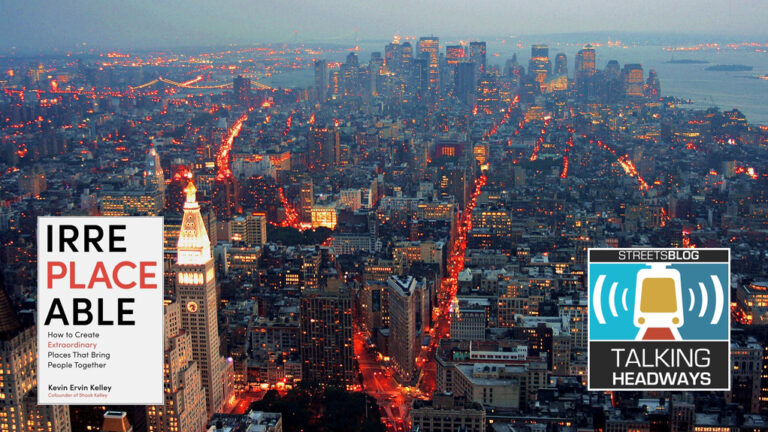This week on the Talking Headways podcast, we are joined by Kevin Kelley, founding partner and principal at Shook Kelley, to talk about his book. Irreplaceable Places: How to Create Special Gathering PlacesWe discuss eliciting emotion, the debate between theme and authenticity, the changing meaning of the city, and embracing density.
Scroll below the audio player for an edited excerpt from the conversation, or click here for an unedited, AI-generated transcript of the entire conversation.
Jeff Wood: How do you see the city at this point? The pandemic has forced a lot of people to work from home. It’s turned the downtown monoculture into something that, frankly, people are scared of, and it’s reinforced this idea of a doom loop. What are your thoughts on that movement and the changes that are happening and the movement to bring people back downtown as we try to bring people into the stores and create experiences?
Kevin Kelly: Yeah, let me preface that a little bit, because that’s a really great question. There was no guidebook to develop our approach. We had to develop our own convening system and try to blend business, science, and design approaches to build a robust system of place. And that’s really what I like to think about in terms of “system of place,” because a lot of companies lack systems. Like anything else, the more I researched, the more I realized that cities were defined by their ancient agoras, their markets, their bazaars, and not so much by temples or religious sites or courts, but by markets.
The more I studied Old World merchants, the more I realized they understood something we don’t understand about connecting people, not just trading goods but trading values and rituals and traditions, what I call in the book “the great exchange of value” to get away from the word “retail.”
What’s interesting is that most of the insights and suggestions that we have can be traced back 1000 years – the way the human body moves, the way people look at each other, how we connect when the environment really encourages and fosters community, and how we connect when the environment inhibits that behavior. But around 2008, 2009, and since then, around the time of the iPhone, social media, Facebook, Twitter, we started to see significant differences, and people’s behaviors escalated.
Internally, alarm bells started ringing that this was a fundamental change in our behavior. When people make less eye contact or keep their head down all the time, it sends a different signal to us. To a child, head down means depressed. Even before they know the word depressed, they know their parent is in a bad mood. We started noticing this behavior and became very concerned about the nature of community building. Add to that our obsession with online shopping and, you know, 7-8 hours of screen time a day on average, and it gets scary.
I mean, 105 days out of the year you’re glued to your screens and not communicating in public. That was worrying enough. Then the pandemic hit, and I work in a lot of downtowns and some global cities and the urban areas that I mentioned, and when the pandemic hit, we saw much more long-term effects. A lot of other sectors, residential, retail, believe it or not, are doing well despite the headlines. A lot of other sectors are doing well. The sectors that are super problematic are the downtowns and urban areas, the office market. This is a fundamental change in our behavior that I think will take a decade to correct and it’s going to be a problem for everybody.
There’s this idea of suburbs and inner cities, and people think, “That’s not my problem, but it’s all of us’ problem in terms of tax base and services.” What is the solution? This is one of the things we’re working on with some cities. I think you have to break it down into many aspects, but the bottom line is that you have to change what you mean by city from a place of production. [to places of] Proximity. They’re built on the idea of being close to resource factories and other workers and the powerhouses that are actually providing the experiences and play areas, and that’s not all bad.
I think it will come back if more people live there and more people spend time there. As many other authors have stated, downtown is a marriage market for young people, and there is a sense of discovery and adventure, creativity and innovation. Cities need to really shape their value proposition. But what I find in many of the cities around the world that I work in is that they are trying to sell the old way of doing things. And that old way of doing things is not working anymore. You are not going to convince the best talent to come to the city and work hard for what they get in return. And I explain in the book a lot of parameters about the amount of work you put in as a human being and the return you get.
The Internet has wiped out all the tangible linear benefits: speed, efficiency, price, variety. The Internet has systematically attacked that and will continue to attack that, but it doesn’t have a monopoly on pleasure, enjoyment, and solidarity. Cities really need to focus on those aspects.

